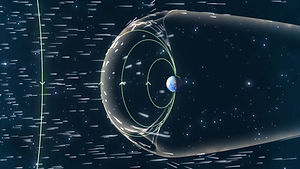
Aurora
From time to time our webcam at the Princess Elisabeth Station captures some beautiful Aurora in the Antarctic sky.
Curious about Aurora? Let’s discover!
Auroral Oval
We are lucky to be located at 71°57' South, the region often covered by the Southern Auroral oval. An Auroral oval is a ring with high probability of Aurora, located at c. 60-70°S and at 60-70°N.
Aurora exists in the Northern Hemisphere as Aurora borealis, and in the Southern Hemisphere as Aurora australis. It typically occurs at a height between 80 and 500 km in the atmosphere.

Picture: NASA
What causes Aurora?
The sun is an active star that continuously emits energy into space in the form of electromagnetic radiation as well as solar wind: charged particles coming from the upper layer of the sun. Sometimes there are stormy outbursts, called Coronal Mass Ejections (CME), releasing a lot of solar material. Just like the Earth, the Sun has a magnetic field, that influences the direction in which particles are travelling away from the Sun.
The Earth's magnetic field, which is caused by movements of masses in the Earth's metal-rich outer core, protects it from these sun borne particles. However, storms and eruptions on the sun, when directed towards the Earth, can cause strong disturbances in the Earth's magnetic field, called geomagnetic storms.

Animation: NASA
The Earth's magnetic field protects it from particles in space.

Animation: NASA
The sun's outbursts of energy can reach the Earth and disturb it's magnetic field, we call this geomagnetic storms.

Animation: NASA
When the electrons reach the Earth's magnetic field, they accelerate along the magnetic field lines and move towards the poles, where they enter the Earth's atmosphere.
They collide with atoms like nitrogen and oxygen, exciting these atoms to higher energy levels. When these, in turn, fall back to their original energy level, they emit light. This happens in the upper atmosphere, between 80 and 500 km height.
Energised particles reach the polar regions via the magnetic field lines of the Earth, resulting in Aurora.
Red Aurora are not very common. They are emitted from Oxygen atoms at around (200 to) 300-500 km height. They occur at lower latitudes than the classic green ones. They are usually associated with geomagnetic storms.
When do we see Aurora?
Cycles: 11 years
The sun's activity is not constant in time, it has an 11-year sunspot cycle, which is in upswing and quite active now (2024). A cycle runs from one solar minimum to the next: it represents the Sun's magnetic activity and it goes with a high or low number of sunspots present on its surface during a solar maximum (with an average peak of 150 sunspots counted in the past 400 years) or minimum respectively. When it approaches its maximum, the Sun's magnetic field also flips around: the magnetic north pole and south pole switch positions.
The number of sunspots at its maximum has not always been constant through history, during the Maunder Minimum (1645-1700), for example, maximum sunspot numbers were almost zero.
Cycles: seasons
Apart from the 11-year cycle, there's also a seasonality: each year around the equinoxes - thus in spring and autumn - Auroral activity is higher. This phenomenon was first explained in 1973 by Russell & McPherson, and is hence called the 'Russell-McPherron effect'. On top of this effect, there's also a so-called equinoctial effect.
The Sun's magnetic field can be prolonged or carried towards Earth by eruptions from the solar surface ( solar wind). The magnetic fields of Earth and Sun are not parallel to one another: we know the Earth's axis is tilted around 23,5° towards (or away from, depending on the season and hemisphere) the sun. Twice a year, however, the axis of the Earth is not tilting away from or towards the Sun, but is semi-parallel to the North-South axis of the sun's magnetic field. This constellation allows more charged particles to enter the polar cusps in the Earths magnetic field, causing more and stronger Auroras.
Impact of Aurora
Space weather (i.e. varying conditions of the Sun, solar wind and surrounding space of the Earth or another planet) impacts technology both on Earth and in Space. It can disrupt satellite communications, GPS signals and even power grids. It also poses risks to astronauts and spacecrafts by increasing radiation levels. Scientists monitor space weather to mitigate these risks and protect critical infrastructure.
Aurora at Princess Elisabeth Antarctica
We are lucky to be located at 71°57' South, within the region covered by the Southern Auroral oval. This means we oftentimes catch Auroral activity on our webcam at night. Our team rarely sees Aurora live, because our fieldwork season runs from early November till end of February, when the days are very long and nights are short.

This picture was taken on the morning of October 10th, at 01 AM. The camera is pointing to the Southwest.

Aurora is being studied, however, year-round at Princess Elisabeth Antarctica. A team of researchers from NIPR, the Japanese Institute of Polar Research, led by Prof. Kadokura, has installed an Aurora camera on the rooftop of our station. It captures the whole sky in one single 360° image. The research studies the onset mechanisms of auroral substorms, temporal & spatial variations in aurora, and the wave-particle interactions in storms & substorms. Apart from the Aurora camera, there is also a Fluxgate magnetometer, and a GNSS (Global Navigation Satellite System) antenna.
The aurora camera on the roof of the PEA station.



